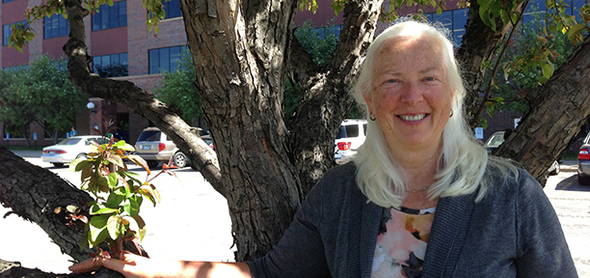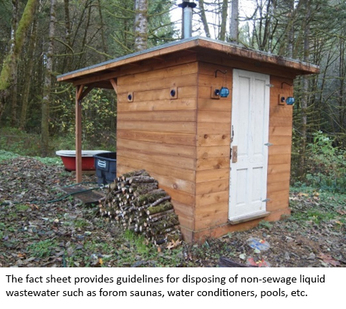 When growing up, Gretchen Sabel’s mother told her there are two kinds of people in the world. One kind gets a pony but becomes unhappy when it produces a big pile of you know what. The other kind sees the big pile and thinks happily, there must be a pony around here somewhere! “She always said I was insanely the second type,” Sabel says.
The ability to stay focused on the positive when dealing with the human version of pony poo has come in handy for Sabel since much of her almost four decades of environmental protection work in Minnesota has been with the MPCA septic system program. She retires this summer after 36 years.
In addition to her personality, Sabel’s background also led her to where she is now. She was part of a team that worked to pass the historic Minnesota Groundwater Protection Act in 1989. “I’m a big picture person and that was big picture,” said Sabel. “People from all these different agencies put their heads together to answer the overall question of, ‘how much degradation/pollution should we allow in our groundwater?’ The answer was, none.” She said the Act laid the groundwork for many groundwater protections that would be adopted by various agencies, including the MPCA.
Shining a light on septic systems
Roughly 25 percent of all wastewater produced by Minnesotans is treated by subsurface sewage treatment systems (SSTS), commonly referred to as septic systems. But it wasn’t until the 1990s that Minnesota through the work of Sabel and others began to take larger steps toward ensuring septic systems across the state don’t contaminate groundwater or surface water, or pose a threat to human health.
In 1996 the state began requiring those who design and install septic systems to be certified and licensed. But the idea of changing from a voluntary system of licensing to one that is mandatory caused some in the industry, counties and Legislature to push back against the new requirements. “There were four of us in the program at that time and our voice mail boxes were always full from people calling with questions or comments,” said Sabel. “We ended up having to hire a student worker just to answer those calls and sort through messages.” In 1999, all counties were required to adopt formal septic system programs to help increase the number of septic systems that met standards. By 2006 all counties had completed this work.
The next big update to septic rules came in 2008. This time too there was resistance. “The county folks stood up and pushed hard for changes they wanted to see and that led to where we are today where we have a special advisory group we work with,” says Sabel. “They let us know what they want and we work with them to figure out how to make it happen. Counties are more directive of the process but at the same time there is more cooperation. This change has shaped our septic program and it certainly has shaped my own thinking on how to implement change… . I appreciate very much what we learned from the experience.”
 Counties completing ordinance updates
The rule updating process begun in 2008 is now nearing completion as counties finish the task of passing updated local ordinances that reflect the new rules. Sabel recently sent letters to more than 80 counties thanking them for all their hard work. She said working with county staffs is one of the things she will miss most about her job. She started with the MPCA in 1978 as a landfill inspector which took her to many counties. “It’s fun to have met these guys so long ago and to still be working with them.”
Among other roles, Sabel has also served in the feedlot program, state planning, the Environmental Quality Board (EQB), and stormwater. During one period she fought to keep Minnesota off the list of potential sites for storing nuclear waste. “My job was to stand at the borders and say ‘no’ to the repository,” she joked.
But she says her legacy will likely be her contributions to the Groundwater Protection Act and moving the septic program to where it is today.
In 2003 the Legislature asked the MPCA to develop a 10-year plan for documenting all septic systems in the state, and identifying and correcting those that don’t comply with standards. Since then, several counties have completed inventories of all of their septic systems and upgraded those that were noncompliant. Most also require septic system compliance checks when a home is sold or when a homeowner applies for a permit to add a bedroom. These and other measures have improved the compliance rate across the state, and greatly reduced the number of homes and small communities that were discharging untreated or under-treated waste directly to nearby waterways via “straight pipes.”
Sabel says Minnesota is different than other states when it comes to support for regulations designed to keep groundwater and surface water clean.
“I came from Pittsburgh and there we had a highly degraded environment where you just hoped things got less bad,” she says. “So I left a place where you coped with pollution to one where you don’t tolerate it. That really made me feel good about being here.”
(A retirement gathering is planned for Gretchen. See Calendar below. Another longtime MPCA septic program staffer, Ron Swenson, is also retiring this summer. More about his story in the next issue.)
|
As noted in the May SSTS Bulletin, the MPCA is offering grants to counties for administering SSTS programs, special projects to improve SSTS compliance rates, and to assist low-income homeowners with SSTS upgrades.
The MPCA will determine grant allocations after reviewing all the applications. Funds will flow to counties through the Board of Water and Soil Resources (BWSR) Natural Resources Block Grants (NRBG) beginning in July, 2014.
An email was sent in May to all counties with details of the grant application process. This week a followup email was sent extending the application submission deadline to June 19 at 3:30 p.m.
The application form is set up to automatically email your completed application back to ssts.projects.mpca@state.mn.us .
If you have problems with this function, you can save the form and attach it to an email to that same address. An auto-reply function is set up to confirm that your application was received. The goal is to notify grant recipients of awards during the first week of July.
A WebEX meeting was held May 21 to answer questions about the grants. The notes from this meeting have been emailed to each county. If you still have questions, please send them to ssts.projects.mpca@state.mn.us or call Aaron Jensen at 651-757-2544. A PDF copy of the grant application is available on the MPCA’s website.
 By Nick Haig
The MPCA is seeking volunteers to assist with the piloting of SSTS exam questions. We hope to create a monthly gathering of volunteers to work through a large number of questions in need of review and validation. Please consider being a part of the group of experienced professionals that has already completed the required training and testing to help us improve SSTS exams.
The first two sessions will focus on the Advanced Design and Inspection exam. From there, we will focus on Intermediate Design and Inspection, before moving into Basic Design and Basic Inspection specialty areas during the 2014/2015 cycle.
The first session is scheduled for July 10, 2014. Additional dates will be scheduled by the group. This is not a long-term commitment – feel free to participate in any or all sessions as your schedule allows.
Each day will consist of two three-hour sessions at the MPCA St. Paul office. You are invited to participate in the morning, afternoon, or both sessions to review and provide feedback on potential exam questions. Lunch will be provided for all volunteers.
We will attempt to replicate a “mini-exam” session (completely confidential) and then walk through each question as a group to collect your feedback. The discussion that occurs about exam questions has been reported by prior participants as “interesting,” “helpful,” and “skill-sharpening!”
Contact Nick Haig at the MPCA to express your interest in joining this important group. Or call 651-757-2536.
|
 By Mark Wespetal
The MPCA has created a new fact sheet, “Disposal of non-sewage wastes from single-family dwelling served by SSTS.”
The fact sheet provides guidance on the discharge from water conditioners, furnace condensate, pool water, sauna floor drains, geothermal discharges and other non-sewage wastes for single-family dwellings served by septic systems.
There were many contributors and reviewers. Thanks to all who helped.
|
 |
|
By Dave Schulenberg
Executive Director, Minnesota Water Well Association
Recently, the Minnesota Water Well Association was informed of septic crews obtaining and processing water samples from private wells at the time of the sale of property inspection, and during this time offering the service of chlorinating the well to disinfect it.
It's important to remember the only persons authorized to disinfect a water well in Minnesota are those with a well contractor license, a pump installer's license obtained through the Minnesota Department of Health under MN Chapter 4725 and MN Statute 103I, or the well owner.
Those with questions may contact the Minnesota Department of Health at 651-201-4600 or the Minnesota Water Well Association at 800-332-2104.
|
|